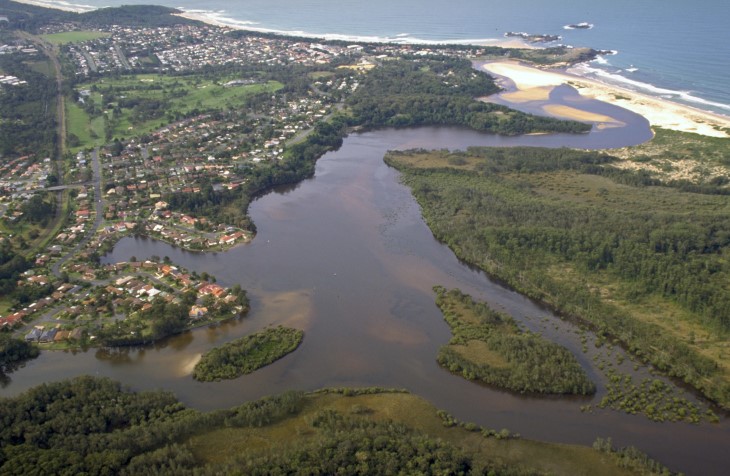Bonville Creek estuary is situated south of Coffs Harbour at Sawtell, on the New South Wales mid-north coast. It is a barrier river estuary with an untrained entrance that becomes quite shallow and constricted to tidal flows at time, but it usually remains open.
The estuary and catchment area is rich with Aboriginal heritage. The adjacent Bongil Bongil National Park translates to a place where people stay a long time.
Water quality report card
As part of our water quality monitoring program we assess the water quality and ecosystem health of an estuary using a range of relevant indicators. We sample a subset of the estuaries located between the Queensland border and Taree every 3 years. The most recent sampling in Bonville Creek was completed over the 2018–19 summer, when 2 sites were sampled on a monthly basis.
This report card represents 2 water quality indicators that we routinely measure: the amount of algae present and water clarity. Low levels of these 2 indicators equate with good water quality.
Algae
Water clarity
Overall grade
The report card shows the condition of the estuary was good with:
- algae abundance graded fair (C)
- water clarity graded good (B)
- overall estuary health graded good (B).
Grades for algae, water clarity and overall are represented as:
- A – excellent
- B – good
- C – fair
- D – poor
- E – very poor.
Go to estuary report cards to find out what each grade means, read our sampling, data analysis and reporting protocols, and find out how we calculate these grades.
Coffs Harbour City Council, in collaboration with the University of New England’s EcoHealth Program, has carried out detailed ecosystem health monitoring in Bonville Creek. The results of the monitoring program, including a detailed water quality report card, are available on the Coffs Harbour City Council website.
We have monitored water quality in the Bonville Creek since 2009. This table shows the water quality grades for this estuary over that time.
| Year | Algae | Water clarity | Overall grade |
|---|---|---|---|
| 2009–10 | B | A | B |
| 2012–13 | C | A | B |
| 2015–16 | D | B | C |
Physical characteristics
| Estuary type | Barrier river |
|---|---|
| Latitude | –30.38 (ºS) |
| Longitude | 153.1 (ºE) |
| Catchment area | 113.5 km2 |
| Estuary area | 1.7 km2 |
| Estuary volume | 1466.1 ML |
| Average depth | 1 m |
Tidal exchange volume
Tidal exchange volume or tidal prism data is available for this estuary. This tidal prism was measured in 1997.
| Tide state | Flow (ML) | Local tidal range (m) | Sydney Harbour tidal range (m) |
|---|---|---|---|
| Ebb flow | 740 | 0.48 | 1.4 |
| Flood flow | 750 | 0.51 | 1.52 |
Notes: km2 = square kilometres; m = metres; m3 = cubic metres; ML = megalitres.
Water depth and survey data
Bathymetric and coastal topography data for this estuary are available in our data portal.
Land use
The catchment of Bonville Creek catchment is mostly forest. Much of the lower catchment remains forested and largely protected by a national park, whereas most of the upper catchment has been cleared, originally for timber harvesting and later for grazing, horticulture and rural-residential development. Around 10% of land use is urban, consisting of the suburbs Boambee East, Toormina and Sawtell.
National and marine parks
- Bongil Bongil National Park encompasses much of Bonville Creek estuary and its surrounds.
- This estuary does not flow into a marine park.
Citizen science projects
- Bongil Bongil community koala survey is a citizen science project that calls on community members to help monitor the koala population in Bongil Bongil National Park.
Community involvement
- Coffs Harbour Regional Landcare provides workshops and volunteer work opportunities along the Coffs Coast.
- There are 22 bushcare and landcare volunteer groups in the Coffs Harbour area, including in Sawtell. For more information go to the National Parks and Wildlife Service Coffs Harbour bushcare and landcare webpage.

Aerial view of Bonville Creek estuary.
Local government management
Local councils manage estuaries within their area, unless the estuary is attached to a marine park.
Bonville Creek is managed by Coffs Harbour City Council. Information about this estuary can be found on the council’s Bonville Creek webpage.
Threatened species
Many threatened species live in the Bonville Creek catchment, including a large koala population in Bongil Bongil National Park.
Read more about the biodiversity in our estuaries.